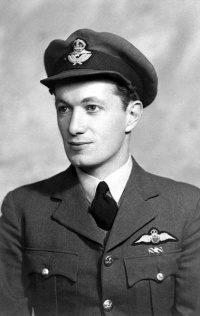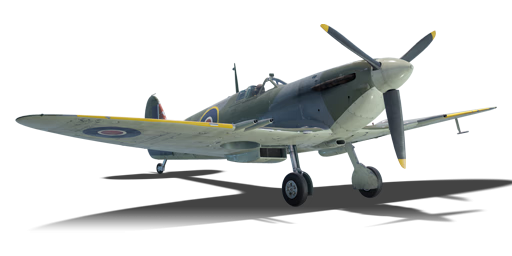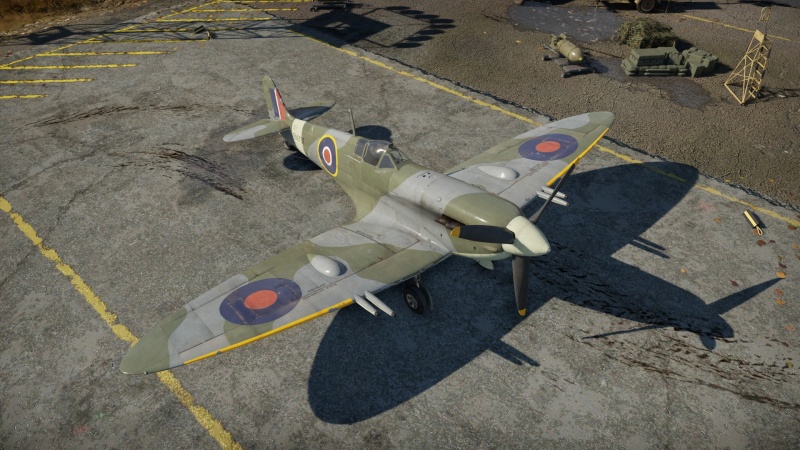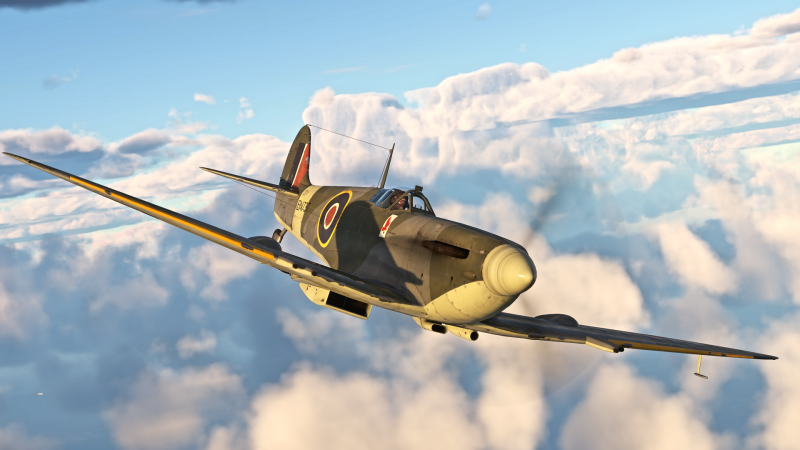Difference between revisions of "Spitfire Mk Vc"
Colok76286 (talk | contribs) (Edits) |
(→Description: Updated to new standard) |
||
| Line 14: | Line 14: | ||
== Description == | == Description == | ||
<!-- ''In the description, the first part should be about the history of and the creation and combat usage of the aircraft, as well as its key features. In the second part, tell the reader about the aircraft in the game. Insert a screenshot of the vehicle, so that if the novice player does not remember the vehicle by name, he will immediately understand what kind of vehicle the article is talking about.'' --> | <!-- ''In the description, the first part should be about the history of and the creation and combat usage of the aircraft, as well as its key features. In the second part, tell the reader about the aircraft in the game. Insert a screenshot of the vehicle, so that if the novice player does not remember the vehicle by name, he will immediately understand what kind of vehicle the article is talking about.'' --> | ||
| − | The | + | The advent of the high-altitude Ju 86 bomber over Britain in late 1940 saw a growing need for a new high-altitude-capable (pressurised) variant of the Spitfire. A stop-gap solution was presented in the Spitfire Mk V, a [[Spitfire Mk Ia|Mk I]] airframe fitted with a new Merlin 45 engine, producing 1,440 hp and incorporating a new single-stage supercharger, as well as other improvements including a carburettor able to handle zero-G manoeuvres without fuel flow issues. The Mk Vc in particular was the first variant of the Spitfire to be fitted with the "C-type" or "Universal" wing, heavily redesigned to reduce manufacturing time as well as allowing a wide variety of armament layouts to be equipped without the need for structural modifications. The C-type wing was commonly fitted with an all-cannon loadout of 4 x 20 mm Hispano cannons, which could also be belt-fed in the new wing design, doubling their ammunition capacity compared to those in the B-type wings. With the quick introduction of the [[Spitfire F Mk XI]] in order to counter the rising threat of the [[Fw 190 (Family)|Fw 190]], the Mk Vc saw little combat over Europe. However, Spitfire Mk Vs were commonly operated overseas, resulting in their [[Spitfire Mk Vc/trop|tropicalised counterparts]]. |
| + | |||
| + | Introduced in [[Update 1.77 "Advancing Storm"]], the Mk Vc will commonly be matched against planes such as the [[Bf 109 G-2/trop]], which performs better in the vertical (climbing/diving), or the [[A6M5]], which performs better in the horizontal (turning). While this aircraft faces tricky opposition, it is far from helpless as one might expect from what is essentially the airframe of a [[Spitfire Mk Ia]]. The Spitfire Mk Vc has two major advantages over its opposition: turn performance, engine performance below 3,000 m, and armament. The plane is blessed with a Merlin 45M engine that grants it phenomenal acceleration below that altitude compared to German opposition, as well as a hard-hitting armament of four Hispano Mk II cannons that gives it an exceptionally high burst mass of 5.17 kg/s, putting it on the same level as the [[Fw 190 A-5]]. The Mk Vc has marginally better performance over its preceding [[Spitfire Mk Vc/trop|tropicalised counterpart]] due to the lack of air filters and other modifications, although the difference is rather minimal. | ||
== General info == | == General info == | ||
Revision as of 18:42, 23 July 2023
| This page is about the British fighter Spitfire Mk Vc. For the tropical version, see Spitfire Mk Vc/trop. For other versions, see Spitfire (Family). |
Contents
Description
The advent of the high-altitude Ju 86 bomber over Britain in late 1940 saw a growing need for a new high-altitude-capable (pressurised) variant of the Spitfire. A stop-gap solution was presented in the Spitfire Mk V, a Mk I airframe fitted with a new Merlin 45 engine, producing 1,440 hp and incorporating a new single-stage supercharger, as well as other improvements including a carburettor able to handle zero-G manoeuvres without fuel flow issues. The Mk Vc in particular was the first variant of the Spitfire to be fitted with the "C-type" or "Universal" wing, heavily redesigned to reduce manufacturing time as well as allowing a wide variety of armament layouts to be equipped without the need for structural modifications. The C-type wing was commonly fitted with an all-cannon loadout of 4 x 20 mm Hispano cannons, which could also be belt-fed in the new wing design, doubling their ammunition capacity compared to those in the B-type wings. With the quick introduction of the Spitfire F Mk XI in order to counter the rising threat of the Fw 190, the Mk Vc saw little combat over Europe. However, Spitfire Mk Vs were commonly operated overseas, resulting in their tropicalised counterparts.
Introduced in Update 1.77 "Advancing Storm", the Mk Vc will commonly be matched against planes such as the Bf 109 G-2/trop, which performs better in the vertical (climbing/diving), or the A6M5, which performs better in the horizontal (turning). While this aircraft faces tricky opposition, it is far from helpless as one might expect from what is essentially the airframe of a Spitfire Mk Ia. The Spitfire Mk Vc has two major advantages over its opposition: turn performance, engine performance below 3,000 m, and armament. The plane is blessed with a Merlin 45M engine that grants it phenomenal acceleration below that altitude compared to German opposition, as well as a hard-hitting armament of four Hispano Mk II cannons that gives it an exceptionally high burst mass of 5.17 kg/s, putting it on the same level as the Fw 190 A-5. The Mk Vc has marginally better performance over its preceding tropicalised counterpart due to the lack of air filters and other modifications, although the difference is rather minimal.
General info
Flight performance
| Characteristics | Max Speed (km/h at 3,963 m) |
Max altitude (metres) |
Turn time (seconds) |
Rate of climb (metres/second) |
Take-off run (metres) | |||
|---|---|---|---|---|---|---|---|---|
| AB | RB | AB | RB | AB | RB | |||
| Stock | 577 | 558 | 10500 | 17.2 | 17.8 | 14.6 | 14.6 | 340 |
| Upgraded | 643 | 602 | 15.8 | 16.2 | 27.3 | 19.7 | ||
Details
| Features | ||||
|---|---|---|---|---|
| Combat flaps | Take-off flaps | Landing flaps | Air brakes | Arrestor gear |
| X | X | ✓ | X | X |
| Limits | ||||||
|---|---|---|---|---|---|---|
| Wings (km/h) | Gear (km/h) | Flaps (km/h) | Max Static G | |||
| Combat | Take-off | Landing | + | - | ||
| 760 | 270 | N/A | N/A | 230 | ~10 | ~5 |
| Optimal velocities (km/h) | |||
|---|---|---|---|
| Ailerons | Rudder | Elevators | Radiator |
| < 321 | < 400 | < 350 | > 450 |
| Compressor (RB/SB) | ||
|---|---|---|
| Setting 1 | ||
| Optimal altitude | 100% Engine power | WEP Engine power |
| 3,800 m | 1,200 hp | 1,704 hp |
Survivability and armour
- 38 mm Bulletproof glass - Armoured windscreen
- 4 mm Steel - Armoured pilot's seat, coupled with another
- 7 mm Steel - Behind the pilot's seat
- 6 mm Steel - Behind the pilot's head
- 3 mm Steel - Armoured plate in front of engine above propeller
- 1 mm Steel - Armoured plate in front of front top fuel tank
- 3 mm Steel - Armoured plates around ammunition
Modifications and economy
Armaments
Offensive armament
The Spitfire Mk Vc is armed with:
- 4 x 20 mm Hispano Mk.II cannons, wing-mounted (120 rpg = 480 total)
Usage in battles
The Spitfire Mk Vc does not have as high a climb rate as other Spitfires, but it does make up for this in manoeuvrability and firepower. Like all Spitfires, this one is a very good at turning with nearly any opponent that it might face. Trying to lure the enemy into extended turnfights is one of the most effective tactics to use in this plane. Thanks to a decent straight-line energy retention, the plane can also boom and zoom fairly well. However, keep in mind that control surfaces do suffer from compression at high speeds. Roll rate is dramatically reduced above 600 km/h, and elevator authority similarly suffers above 700 km/h. This can make it difficult to get guns on target in high-speed boom and zoom runs.
As for firepower, this vehicle is armed with 4 x 20 mm cannons. Being wing-mounted, convergence is important for these guns, but they can do considerable damage if they connect. It is recommended to set a convergence of 300-400 m, and to hold fire unless at these close ranges.
The Mk Vc's engine has high fuel consumption when using WEP. So, it is important to keep an eye on remaining fuel levels, and on certain maps it may be necessary to take high fuel loads.
In a straight line, the Spitfire's top speed cannot compete with many of its American and Russian counterparts. You may sometimes find yourself being chased down by faster aircraft, and in these scenarios the best thing to do is either to look for teammates to back you up or to try luring them gradually into a turnfight.
Manual Engine Control
| MEC elements | ||||||
|---|---|---|---|---|---|---|
| Mixer | Pitch | Radiator | Supercharger | Turbocharger | ||
| Oil | Water | Type | ||||
| Controllable | Controllable Not auto controlled |
Not controllable Not auto controlled |
Controllable Not auto controlled |
Separate | Not controllable 1 gear |
Not controllable |
Pros and cons
Pros:
- Excellent turn rate
- Higher than average acceleration
Cons:
- Low top speed
- Low ammo count
- Poor climb rate compared to other Spitfires
- High fuel consumption when using WEP
History
| Archive of the in-game description | |
|---|---|
|
A single-seat, single-engine all-metal monoplane fighter, this variant of the Spitfire Mk V was fitted with the new Type C "universal" wing, capable of being fitted with a variety of armaments. The Mk VC could be fitted with four 20 mm Hispano cannons, or it could carry two 20 mm Hispano cannons and four 0.303 inch Colt-Browning Mk II machine guns. The cannons in the type C wings had a tape supply and so could carry up to 120 rounds per gun, unlike the type B wings, which were limited to 60 rounds. In addition, the Mk VC had other modifications to the airframe such as a strengthened fuselage, more armour, larger oil cooler and a new windscreen design. Production of the Mk VC variant began in October of 1941, with the first aircraft being equipped with a Rolls Royce Merlin 45 or 46. However, with the appearance of the German Focke-Wulf FW190 fighter, Spitfire pilots found themselves being outmanoeuvred at low and medium altitudes. The Mk VC was then fitted with Merlin 50, 50A, 55, and 56 engines. To improve performance characteristics at low and medium altitudes, some of these engines were fitted with a cropped supercharger impeller to allow maximum power to be reached at lower altitudes. Engines designed this way included the 45M, 50M, and 55M. On the lower altitude models, further changes were implemented. To reduce drag and moment of inertia on the aircraft's longitudinal axis, the wingspan was reduced and the elliptical wingtips were redesigned to be nearly rectangular. Fighters designed with low-altitude combat in mind were designated Spitfire LFMk Vs (Low Flight). Aircraft optimized for mid-altitude combat were designated Spitfire FMk Vs (Flight) and fighters fitted with the Merlin 46, 50A, or 56 were designated Spitfire HFMk Vs (High Flight) and had an increased wingspan with elongated, elliptical wingtips. The Spitfire VC fought in all theatres in which the RAF was active from 1941 to 1944. A total of some 6,500 Spitfire Mk V fighters were produced, of which 2,467 were Mk VCs. | |
Notable pilots

Media
- Skins
See also
- Related development
External links
- [Devblog] Spitfire Mk.V: model update and new modifications
- Official data sheet - more details about the performance
| Supermarine | |
|---|---|
| Spitfires | |
| Merlin engine | Spitfire Mk Ia · Spitfire Mk IIa · Spitfire Mk.IIa Venture I · Spitfire Mk IIb |
| Spitfire Mk Vb · Spitfire Mk Vb/trop · Spitfire Mk Vc · Spitfire Mk Vc/trop | |
| Spitfire F Mk IX · Spitfire F Mk IXc · Spitfire F Mk XVI | |
| Spitfire LF Mk IX · Plagis' Spitfire LF Mk IXc | |
| Griffon engine | Spitfire F Mk XIVc · Spitfire F Mk XIVe · Prendergast's Spitfire FR Mk XIVe · Spitfire F Mk XVIIIe · Spitfire F Mk 22 · Spitfire F Mk 24 |
| Export | ▄Spitfire Mk Vb/trop · ▃Spitfire LF Mk IXc · ▂Spitfire Mk IXc · Spitfire Mk IXc · Spitfire Mk.IX (CW) · Weizman's Spitfire LF Mk.IXe · ▄Spitfire FR Mk XIVe |
| Seafires | Seafire LF Mk.III · Seafire F Mk XVII · Seafire FR 47 |
| Export | ▄Seafire LF Mk.III |
| Jet fighters | Attacker FB 1 · Attacker FB.2 · Scimitar F Mk.1 · Swift F.1 · Swift F.7 |
| Hydroplanes | Walrus Mk.I |






